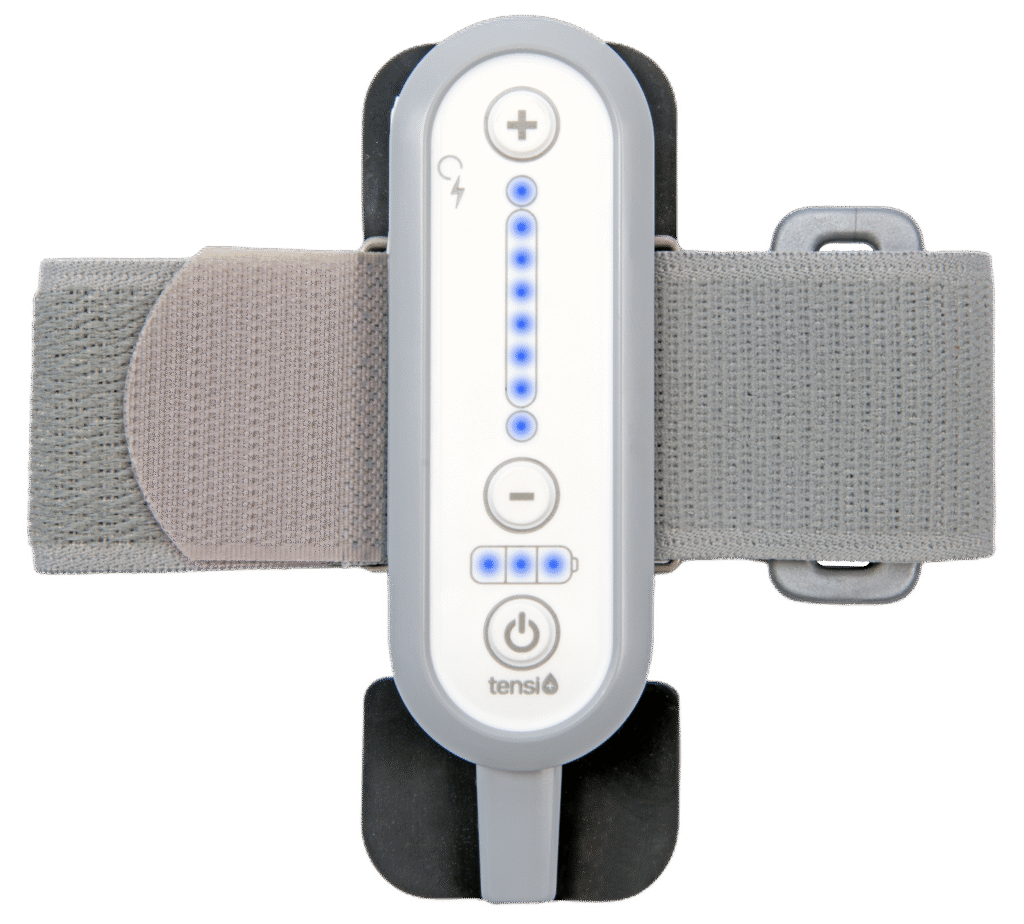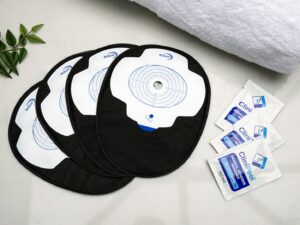This case study explores the real-life experiences of five patients who successfully used Tensi+ to manage overactive bladder (OAB) symptoms. Their stories illustrate how this non-invasive, self-administered therapy, designed for use at home, helped reduce urgency and frequency, improve sleep, and restore confidence and independence.
Breaking Free From Overactive Bladder
Five journeys to better living
This case study explores the real-life experiences of five patients* who successfully used Tensi+ to manage overactive bladder (OAB) symptoms. Their stories illustrate how this non-invasive, self-administered therapy, designed for use at home, helped reduce urgency and frequency, improve sleep, and restore confidence and independence.
Every day, millions of people across the UK quietly struggle with the challenges of overactive bladder (OAB).1 This chronic condition is defined by a sudden, urgent need to pass urine, often with little warning.2,3 It can also involve going to the toilet far more often than normal during the day, and waking several times at night to urinate (a symptom known as nocturia).2,3 For some, these difficulties are compounded by leakage or pain, making an already disruptive condition even more challenging to live with.
Although OAB is not life-threatening, its consequences extend well beyond the bladder. The constant need to locate a toilet, the lack of restful sleep, and the unpredictability of symptoms can erode confidence and independence. Many people find themselves planning journeys around bathroom access, declining social invitations, avoiding activities they once enjoyed, or even feeling limited in their ability to work. Over time, the condition can take a toll not only on physical health, but also on emotional wellbeing, relationships, and overall quality of life.
OAB is far from rare, affecting over 5 million adults in the UK.1 Too often, individuals dismiss their symptoms as an inevitable part of ageing, or endure them in silence due to embarrassment or a lack of awareness about available treatments. Clinicians too recognise the challenges: while several therapies exist, each has its limitations in terms of effectiveness, side effects, or accessibility.
Finding treatments that are both effective and manageable is essential, so that people can move beyond the limitations of OAB and reclaim a better quality of life.
Current options for managing OAB
For most people, the first step in managing OAB involves making changes to daily habits. Cutting down on caffeine and alcohol, keeping a bladder diary, and practising techniques such as bladder retraining or pelvic floor exercises can sometimes bring relief.2,3 These measures are simple and non-invasive, but they do not always go far enough, particularly for those with more severe or persistent symptoms.
When lifestyle changes are insufficient, medication is usually the next option. The most common prescriptions are anticholinergics, such as oxybutynin or solifenacin, which work by calming the overactive bladder muscle.2,3 While these drugs can be effective, their side effects (dry mouth, constipation, blurred vision) mean that many patients struggle to continue them long-term.2,3 Additionally, emerging research has suggested a potential association between prolonged anticholinergic use and an increased risk of dementia in older adults.4 More recently, beta-3 adrenergic agonists, including mirabegron and vibegron, have provided an alternative.2,3 These tend to be better tolerated, but can sometimes raise blood pressure or cause headaches and so should be used with caution in patients with uncontrolled hypertension.2,3 For some people, neither class of drug offers enough relief.
Beyond tablets, there are other options. Percutaneous posterior tibial nerve stimulation (P-PTNS) involves placing a fine needle near the ankle to deliver gentle electrical impulses that help regulate bladder control.2,3 Many patients respond well, but new patients may face long waiting lists before initiating P-PTNS. Even once started, the treatment involves weekly hospital visits over three months and ongoing maintenance sessions, a time commitment which can be challenging to sustain.
For those with more severe or resistant symptoms, more invasive procedures may be considered. Botulinum toxin (Botox) injections into the bladder muscle can reduce urgency and frequency, but carry a risk of urinary retention, sometimes requiring patients to use intermittent self-catheters (ISC).2,3 Sacral nerve stimulation (SNS), which involves surgically implanting a small device to stimulate the nerves controlling the bladder, can also provide benefit, but the procedure is complex, outcomes vary, and it is not suitable for everyone.2,3 Despite this range of approaches, many patients find themselves caught between treatments that are either difficult to tolerate, hard to access, or unsustainable in the long term.
Tensi+: A new way to manage OAB
Tensi+ is a non-invasive device designed to give people with overactive bladder more control over their symptoms. It works by delivering gentle electrical impulses to the tibial nerve near the ankle, helping to rebalance the signals between the bladder and the brain and reduce the urgency and frequency of urination.5
Unlike traditional P-PTNS, which requires repeated clinic visits and needle-based equipment, Tensi+ is designed for comfort, convenience, and independence.5
The device is secured around the ankle and delivers stimulation through two skin electrodes – one placed just below and behind the inner ankle bone (medial malleolus) and the other positioned slightly above it.5
Treatment involves a simple 20-minute session each day for 12 weeks, followed by regular top-up sessions to maintain symptom relief.5 No needles, no invasive procedures, and no interruption to daily routines.

While Tensi+ uses similar underlying technology to standard transcutaneous electrical nerve stimulation (TENS) devices, it is not the same as the machines you might find online. Ordinary TENS units are designed for general pain relief, whereas Tensi+ is CE-marked, MHRA-registered, and clinically tested specifically for OAB. Moreover, it is fully compliant with the stringent guidelines set by the Medical Device Regulations (MDR). With optimised fixed settings and tailored electrode placement to ensure the correct nerve is stimulated every time, it offers both precision and simplicity, giving patients the best chance of success.
Tensi+ bypasses many of the barriers associated with existing therapies, such as medication side effects, long hospital waiting times, or the risks of invasive surgery, while still addressing the underlying nerve pathways involved in bladder control. For many people, this balance of effectiveness, safety, and practicality makes Tensi+ an appealing option in the management of OAB. The real impact of Tensi+ is most evident in the experiences of patients who have used it to break free from the daily challenges of OAB.*
Regaining confidence and control
Joanna
Joanna is a 58-year-old from Hampshire who had been struggling with an overactive bladder for four years. Her daily life was made even more challenging by other health conditions (multi-system autonomic neuropathy and Sjogren’s Syndrome), which added to the difficulty of managing frequent and urgent trips to the bathroom.
Despite her efforts with lifestyle adjustments and intermittent P-PTNS therapy, relief was inconsistent, and long-term improvement remained elusive.

Under the guidance of her urogynaecology specialist, Joanna began using Tensi+ with great results. Her average daytime trips to the bathroom dropped from 35 to 18, with urgency markedly reduced. Nighttime awakenings, once numbering up to 15, fell to under 10, with a notable improvement in her sleep.
The benefits extended beyond the numbers. With fewer interruptions and less urgency, Joanna regained confidence when leaving home and felt able to participate in social activities and hobbies without constant concern about bathroom access. The improved sleep and reduced stress enhanced her overall well-being, energy, and enjoyment of daily life.
Restoring restful sleep
Alan
Alan, a 76-year-old retired gentleman, had long been troubled by frequent nighttime urination that left him exhausted during the day. Getting up 7 or 8 times a night to use the bathroom meant he rarely enjoyed uninterrupted sleep, and the fatigue carried over into every part of his daily life.
When he began using Tensi+, Alan was skeptical. Even after six weeks, he was unsure whether it was making a difference. However, with continued use, the improvements became clear. By twelve weeks, his nights looked completely different: instead of waking repeatedly, he now only got up once or twice, and some nights he didn’t need to get up at all.

The benefits didn’t stop there. Alan noticed he felt more in control during the day, with less urgency and greater relaxation around his bladder symptoms. He also noted that his bowel movements had become more predictable. Importantly, he found Tensi+ easy to use and simple to fit into his daily routine, which made sticking with the treatment stress-free.
For Alan, the greatest change was the return of restful sleep. With his nights no longer dominated by bathroom visits, he woke feeling more refreshed and energised. This newfound stability boosted his confidence, reduced his anxiety about bladder control, and allowed him to enjoy social activities again without constant worry.
Rapid relief and renewed independence
William
William is 82 and had been living with the challenges of OAB for more than five years. Despite trying both lifestyle adjustments and medication, nothing seemed to ease his symptoms. The constant need to find a bathroom left him feeling trapped, to the point where even using public transport or going out for social occasions felt impossible.
On the recommendation of his consultant, William decided to try Tensi+. To his surprise, he began noticing changes within just a few weeks. Where he once made countless trips to the bathroom during the day, he now goes no more than 12 times, and the urgency that had dictated his daily routine has eased considerably, especially in the afternoons and evenings.

William found Tensi+ simple to use and, more importantly, effective in a way that other approaches had not been. With his bladder under better control, he has regained both his independence and his peace of mind. Social outings, travel, and day-to-day activities are once again possible – a change he describes as nothing short of life-changing.
The improvements at night have been equally significant. Instead of waking 5 or 6 times, he now gets up no more than 2 or 3 times, giving him longer stretches of uninterrupted rest. For the first time in years, he feels confident enough to drive for an hour without worrying about where the nearest toilet is.
Regaining control after years of struggle
Colin
Colin, a 74-year-old retiree from Carmarthenshire, had lived with the challenges of OAB for most of his adult life. An enlarged prostate added another layer of difficulty, intensifying his urinary urgency and frequency. Over the years, he had tried different approaches to manage his symptoms, but nothing provided consistent or lasting relief, and he was reluctant to continue with long-term medication.
The constant need to plan his day around bathroom access was both tiring and restrictive. Nights were equally disrupted, with three or four trips to the toilet, leaving him exhausted by morning.

When his consultant recommended Tensi+, Colin was open but cautious, having experienced many disappointments in the past. To his delight, he found the treatment straightforward to use and simple to integrate into his daily routine. Within just a few weeks, improvements were clear. Daytime trips to the toilet decreased with urgency becoming less overwhelming. The change was even more striking at night: he now typically gets up only once or twice, and often returns to sleep more easily.
After years of struggling to find anything that worked, Colin describes the difference as transformative. Tensi+ has helped him achieve better bladder control and, with it, greater confidence and freedom in his daily life.
Finding relief from persistent bladder pain
Richard
Richard is in his early seventies living in London and had been living with bladder problems for many years. Alongside urgency and frequency, his most troubling symptom was the significant pain linked to his overactive bladder. This ongoing discomfort affected his mood, disrupted his daily routines, and left him feeling restricted in how he could live his life.
On the advice of his consultant, Richard was placed on the waiting list for sacral nerve stimulation (SNS). While awaiting the procedure, he was introduced to Tensi+ as a possible option. Within just a few weeks of starting therapy, he noticed a marked reduction in pain, describing the change as the best he had felt in years. For the first time in a long while, he could enjoy simple activities without being overshadowed by constant discomfort.

When Richard eventually underwent SNS, he was surprised to find that it did not bring the same level of benefit he had already experienced with Tensi+. Although he remains hopeful that the procedure will offer improvement over time, his experience with Tensi+ gave him meaningful relief and restored a sense of control over his symptoms.
With pain eased and bladder control improved, Richard has been able to re-engage more fully with daily life. Sleep, social activities, and his overall sense of wellbeing have all benefitted, leaving him better able to focus on the things he enjoys most.
How Tensi+ makes a difference
For many patients living with OAB, Tensi+ has made a tangible difference in daily life. People like Joanna, Alan, William, Colin, and Richard have reported improvements in sleep, with fewer nighttime trips to the bathroom, as well as reduced daytime urgency and frequency. These changes have allowed them to leave home more confidently, engage in social activities, and plan their days without constant concern over toilet access, restoring a sense of independence and improving overall quality of life.
Tensi+ is non-invasive and designed for home use, offering a practical alternative to long-term medication or repeated clinic visits. Its versatility means it can benefit a wide range of patients, including those with long-standing OAB, coexisting health conditions or differing symptom patterns.
Unlike generic TENS machines, which are intended for broad use, Tensi+ is purpose-built for OAB. Its fixed settings and tailored design ensure the correct nerve is targeted consistently, supporting reliable outcomes and making it easier for patients to stick with treatment.
All five patients featured in this article* highly recommend Tensi+ to others managing OAB, underscoring the real-world benefits of this patient-centred approach. By helping people take control of their bladder health in a convenient and accessible way, Tensi+ offers a meaningful option for those seeking relief and greater confidence in everyday life.
*The case studies presented are based on real patient experiences; identifying details have been anonymised to protect patient confidentiality. The information provided is for educational purposes only and should not replace clinical judgment or individualised patient care.
References:
- The Urology Foundation. Overactive Bladder: Who’s Counting? 2025. Available at: https://www.theurologyfoundation.org/impact-achievements/campaigns/overactive-bladder-whos-counting/ (Accessed August 2025).
- European Association of Urology. Management of Non-Neurogenic Female Lower Urinary Tract
Symptoms. 2024. Available at: https://uroweb.org/guidelines/non-neurogenic-female-luts/ (Accessed August 2025). - European Association of Urology. Management of Non-Neurogenic Male Lower Urinary Tract Symptoms. 2024. Available at: https://uroweb.org/guidelines/management-of-non-neurogenic-male-luts/ (Accessed August
2025). - Iyen B, et al. BMJ Med. 2024;3(1):e000799.
- Cornu JN, et al. Can J Urol. 2023;30(6):11756-11761


